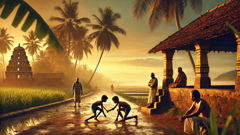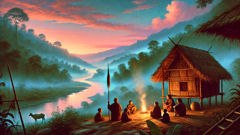Introduction
Along the narrow coastal roads and in the rice fields between Mangalore and Puttur, where the monsoon leaves the earth black and fragrant and the Arabian Sea murmurs a low unending song, the names Koti and Chennayya are spoken with a steady cadence. They are not only names but a rhythm in the collective memory of Tulu Nadu: twin brothers born beneath an auspicious comet, raised amid salt wind and temple bells, who bent their lives toward an unyielding pursuit of justice. Their story begins in a small hamlet that knew the regular law of landlords and the rawer law of survival, where contract debts and local power could crush a household overnight. Into that uneven world the twins came — not as conquerors, but as responsibility made flesh. This narrative does not present them as distant idols behind glass. It traces their waking days, the sound of their boots on wet earth, the arguments they had with their mother under a Kerala banana tree, their laughter with friends, and the terrible choices at the center of every heroic tale: to stay safe or to act. Their courage stitched itself into ritual: after their deaths the living would call them back as daivas, protective spirits invoked at festivals and in times of calamity. The tale that follows moves between the intimate and the cosmic. It speaks of the land that shaped them — backwaters, coconut groves, temples with wooden chariots — and of the social tensions that forced them to fight. Along the way we meet the figures who tested them: crooked officials who favored their own, a girl who loved one twin more than the other, a band of mercenaries who confused order with brutality, and elders who preached caution even as they whispered admiration for boldness. As you read, imagine incense smoke curling through a coastal dusk, tamarind tang on the tongue, and the steady drum that marks the beginning of the devaru kaatha — the telling of a spirit's story. This is a telling meant to be sung, argued, commemorated and debated, for Koti and Chennayya belong to every home by the paddy bund and to every child who grows up listening to the elders recall the courage of those who refused to be bullied into silence.
Birth, Bloodlines, and the Making of Men
The village that welcomed Koti and Chennayya was the kind that keeps its records in memory rather than in ink. Elders count time by harvests, births, and a storm that once uprooted the oldest tamarind tree on the bund. The twins' mother, a woman known for her steady hands and sharper tongue, labored to provide for her sons after their father fell in a border dispute. They were born on the same night, in the same breath, and from the beginning their lives were braided together. Those early years matter because the pattern of upbringing set their values: their mother taught them to mend nets and to honor promises, and the local temple priest taught them to read the seasons in the flight of birds. Koti, the elder by a heartbeat, had a square jaw and a laugh that could rally a half-assembled crew. Chennayya, quieter, kept his temper like a tool for when it was truly needed. Together they learned the small acts that make communities durable — carrying water for the old woman by the river, defending a child from taunts about a crooked tooth, bargaining for seed rice when markets were tight. These private rites of courage would later be the foundation for public deeds.

Their lineage was a patchwork. The family belonged to a caste that dealt mostly in trade and the tilling of land, not one of princely names or high drama, but the community held a fierce sense of honor. That honor was both a shield and a chain. In coastal Karnataka, where sea traders and inland farmers intersect, disputes were common: an unpaid debt could escalate to raid and revenge; a marriage dispute could split a panchayat into rival camps. Into this charged atmosphere the twins grew, learning to see the difference between law as ink and justice as living reciprocity. They watched as landlords and petty officials exploited loopholes, extracting more than what was fair and bending custom to greed. Over time they felt compelled to act because, as their neighbors said, injustice was contagious and would swallow whole a village if left unchecked.
The brothers' youth was not all fury. There were evenings when lanterns bobbed on the estuary and they would lie on the roof, counting stars and inventing future glories. They learned wrestling on the ground behind the temple, trained with bamboo sticks until their arms ached, and took up the craft of the local smith to understand the temper of steel. Those who watched them recognized a rare alchemy — the mix of physical prowess and moral focus. Soon they became the village's natural arbiters in petty quarrels. People who could not afford a formal hearing came to them for mediation, for their judgments carried the weight of fairness. Where elders wavered, the twins were steady. Word travels fast along trade routes and soon travelers spoke of the two who would not be bent. With every good deed their fame spread, and with fame came attention from those on the other side of power.
The trouble crystallized around a landlord named Karanja, who had recently returned from the city flush with new ideas about revenue and authority. Karanja saw the world as a ledger and a line of control that needed enforcing. He saw the small panchayat leaders who had tolerated local customs as obstacles to be cleared. Tensions escalated when he decided to reassign grazing rights and double the tax on paddy lands without consulting the village council. Those who could not pay faced fines and forced labor. The first time Koti and Chennayya stood against Karanja, it was because an old woman had been seized to pay for a fine that had no moral footing. They marched to the bungalow and demanded redress. When words failed, their fists explained what their words could not. The clash was sudden and fierce, but the brothers' restraint held. They struck with precision and withdrew before the landlord's retainers could form an army.
That confrontation changed the tenor of their lives. It was no longer a matter of local fights; it became a struggle that drew in mercenaries, the colonial intermediaries who sometimes acted as law, and religious leaders who feared the upheaval of longstanding hierarchies. The twins realized that courage had to be matched with strategy. They cultivated allies among fisherfolk, dalits, and small traders who recognized that if the landlord's appetite went unchallenged it would devour everyone. In private councils they brainstormed ways to redistribute risk during lean seasons, negotiated crossroads with bakers and boatmen, and created a network of watchers who could move quickly. Their leadership style was not about centralizing power. Instead, they taught others to argue, to tally debt honestly, and to prepare for harvest festivals where the village's solidarity could be publicly displayed. These festivals, with their drums and ritual dances, became both celebration and a reminder that community could resist predation.
Throughout these years, the brothers' relationship deepened into something that felt less like kinship and more like a shared destiny. They argued, yes — over who should marry and whom to trust — but they always returned to a basic ethic: to uphold the dignity of the weak. That ethic would be tested by love, betrayal, and a string of events that pushed them into open conflict. Yet even in the heat of battles and the solemnity of oaths, there were moments of tenderness: a picnic under the shade of a fig, a private joke that made them both laugh like children, a borrowed flute whose tune became their private anthem. It is easy to mythologize such tenderness, but in Koti and Chennayya's case those small acts are what made them completely human and, later, made their transformation into protector spirits feel authentic to the people who honored them.
The seeds of legend are often sown in episodes of choice. For Koti and Chennayya those episodes accumulated — an unfair confiscation resisted, a ransom refused, a public humiliation turned into a moral lesson. Each victory was narrow and costly and each defeat tempering. But as their reputation grew, so did the threat. It is one thing to defend a village from a single bully; it is another to stand against a system willing to widen its cruelty to preserve itself. At the heart of the story is a simple question: what is one willing to sacrifice when the line between right and wrong is crossed? Koti and Chennayya chose to put the community above their own safety. They argued that honor without action is only a memory, and memory alone will not stop the hungry from pushing others into despair. Their choice set them on a trajectory that braided their names into the rituals and chants of Tulu Nadu, ensuring that even their deaths would not be an end but a transformation into guardians who could be summoned when the village needed moral clarity most.
Feuds, Sacrifice, and the Making of Daivas
As the twins matured, the battles they faced took on larger stakes. When Karanja the landlord realized that intimidation would no longer suffice, he recruited outside muscle and allied with a district officer who turned a blind eye to abuses that filled his pockets. The twins found themselves accused of fomenting unrest. The panchayat, once the center of dispute resolution, splintered as fear and greed blurred moral boundaries. The twins had to think like commanders. They trained villagers in simple defensive maneuvers, organized times for harvests so that labor could be pooled, and, when negotiations failed, arranged public boycotts of the landlord's produce. Those boycotts were radical acts of collective bargaining; they were also risky, since the community depended on trade lines that the landlord could choke. The twins balanced courage with prudence: they assured food caches, established safe meeting places near the estuary, and taught people to read subtle signs of impending raids. Their leadership won them fervent supporters and implacable enemies.

One autumn, a crisis reached a new pitch. Karanja's men set fire to a stack of paddy belonging to a widowed mother who had joined the boycott. The flames licked through the thatch and frightened the village dog into howls that rattled sleeping roofs. That night Koti and Chennayya led men to douse embers and to gather statements from witnesses. Their attempt to bring Karanja to account in front of a visiting magistrate was rebuffed; official reports were filed late, witnesses intimidated, and the magistrate left with a curt apology and a bag of coin. The twins felt the law had betrayed them. Words had failed. In a secret meeting beneath a fig tree they decided that law without conscience would be overturned the way a careless boat overturns in a storm. They could no longer rely on outsiders for justice.
The turning point arrived with a betrayal that cut deeper than tax or theft. A woman named Malli, who had been engaged to Chennayya in a match arranged by elders, was taken by a powerful raider who claimed the match violated some ancient custom. The raider's men dragged Malli away in the light of dusk, and though some in the village urged quiet prayer and negotiation, the twins moved with the fury of men who knew tenderness had been violated. They tracked the band to a beachside grove where the raider celebrated over stolen fish and a bottle of arrack. The fight that followed was not simply a skirmish. It was a revelation of how far those in power would go to assert dominion. Koti and Chennayya fought like men who knew the insides of grief: measured, relentless, and without needless cruelty. They returned Malli to the village, but the victory cost them allies and marked them in the eyes of those who preferred the world ordered by fear.
Their actions did not go unanswered. Karanja and his allies conspired to trap the twins in a guise of legality. A staged incident was arranged: a theft in the market with planted witnesses, signed affidavits and a forged seal. Koti and Chennayya were summoned as criminals. The facade of trial was grotesque. The magistrate, eager to keep peace with the landlord and to avoid costly confrontation, sentenced the brothers to a public ritual meant to humiliate them — a binding ceremony on the riverbank where they would be paraded and then punished. The village gathered in sorrow and indignation. Flowers and supplications misted the air like a plea for reason. But the world that day tipped in a way that made ritual enforcement into a spectacle meant to enforce submission.
In the public square, with the tide pulling at the posts and the community watching, the twins faced their fate. They wore not defeat but an expression shaped by resolve. Koti spoke in a voice that carried on the wind and told of the wrongs done to the widow, the burned paddy, and Malli's abduction. He recited the names of those who had been cowed into silence. Chennayya, with a hand on his brother's shoulder, invoked the ancestors and the moral law that transcended an official's pen. The spectacle could not fully suppress the truth. The crowd, moved, murmured and many wept. Yet the conspirators had arranged that law would be the instrument of sacrifice. The twins' sentence was designed to end their lives in a way that would discourage others. They would be led out to the salt marshes where tide and tide's hunger could claim them.
The marsh is a place where water remembers everything. As they walked, the twins did not plead. Instead they sang the songs of the plantation seasons, the little rhymes their mother taught them, and the same laughter that used to echo on roofs. Their song was a balm for those who walked behind them and a challenge to those who had set the trap. At a narrow channel the executioners pushed them into a dug pit and left them to the slow cruelty of the tide. But what happened next left no room for the petty calculations of men. The community, unable to accept the spectacle, rose in clandestine anger. Friends of the twins rowed under moonlight to the marsh and bribed a guard to tell where the bodies had been left. When the bodies were taken back to the village, the elders performed rites that mixed sorrow with a fierce, unexpected recognition: the twins had not been defeated. In death they seemed, to many, more present than they'd ever been in life. Where their blood touched the earth, new shoots appeared out of season; a child sick through weeks found breath; a stubborn rain broke a drought. Small miracles, mundane but unmistakable, stitched the story together.
It was then the transformation began. In Tulu Nadu the line between living hero and protective spirit is porous. Village narratives are not static; they adapt and assimilate. The community needed guardianship and meaning, and in Koti and Chennayya they found both. The elders, already accustomed to invoking ancestors for blessings, began including the twins in ritual songs. A small shrine was raised, initially on the edge of the paddy, then moved to a more elaborate structure as devotion grew. Priests composed new chants; dancers practiced the brothers' steps; and, crucially, the twins were asked for help in disputes where courts had failed. They became daivas — protector spirits who could be propitiated in times of storm, harvest failure, or moral crisis.
Becoming daivas did not erase their human story. Instead, it folded human memory into ritual practice. The narrative of their bravery became a manual for resistance. Folk plays told the sequence of injustices and the ways the brothers overcame them; young men performed the twins in festivals to rehearse ethical courage; women re-cited the twins' bargains to children as instructions on fairness. The devaru temple where they were honored introduced new customs: after certain rituals, the priest would call upon Koti and Chennayya to witness oaths, and fishermen would ask for safe passage before a voyage. Their cult was not born from abstract worship but out of practical necessity — the village needed champions who would intercede when human law faltered.
Over decades, the cult of the twins expanded beyond their village. Neighboring hamlets adopted similar rituals, each coloring the legend with local detail: one village insisted Koti protected hunters, another claimed Chennayya guarded newlywed houses. The myth's elasticity was its strength. It allowed Koti and Chennayya to be invoked against a range of ills, which kept their memory relevant. Meanwhile, the physical markers of their devotion multiplied: terracotta effigies, painted banners, and songs recorded on worn palm leaves. Along colonial roads new storytellers emerged, including bards who traveled to trade fairs and sang the twins' story for coins. They adapted the tale, adding episodes of cunning and diplomacy, making the brothers not only warriors but wise arbiters.
Finally, the story traveled into the modern era, where schools and local historians argued about dates and particularities. Some wrote of the twins as historical figures who resisted systems of exploitation; others emphasized the mythic meaning of their transformation into daivas. Both readings can coexist because the tale serves different needs: it stands as a parable about community self-defense and as an origin story for ritual practice that gives order and comfort. The living tradition that honors Koti and Chennayya persists precisely because it answers a human query older than law: when institutions fail, to whom does a community turn? For many in Tulu Nadu, the answer remains the same — to the twins who refused to let injustice pass unchallenged, and whose spirits now walk among the living whenever duty demands it.
Conclusion
To tell the tale of Koti and Chennayya is to stand at the meeting place of memory and moral imagination. They were born of ordinary circumstances and became extraordinary through choices that bound them to a people. Their legend teaches a practical ethic: justice demands action and community endures through mutual care. Today their names are chanted in festivals, carved into wooden pillars, and sewn into family narratives; they are invoked in disputes and thanked in harvests. The story's endurance rests on its adaptability — it offers concrete models for resistance while allowing each generation to reframe the brothers' deeds for present dangers. In the end, the most human part of the myth is how people use it: to name the wrongs they see, to imagine better outcomes, and to summon courage when necessary. Koti and Chennayya remain, across centuries, a living presence in village courtyards and temple altars, a reminder that sometimes heroes are the ones who refuse to yield and then give the world a way to remember what honor looks like.













